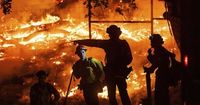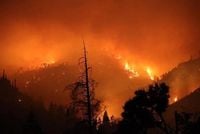As California’s notorious wildfire season rages on, the Pickett Fire in Napa County has become the region’s most significant blaze of the year, threatening homes, vineyards, and the everyday rhythms of life in the celebrated wine country. The fire, which broke out northeast of Calistoga on August 21, 2025, has rapidly expanded, fueled by relentless hot and dry conditions that have gripped much of the state.
By Sunday afternoon, August 24, the Pickett Fire had scorched 6,803 acres, according to the California Department of Forestry and Fire Protection (Cal Fire). Containment remained a challenge, with the fire only 11% under control—an improvement from 7% the previous day, but still a long way from safety. CNN reported a similar figure, noting that evacuations were underway as the fire, at 6,531 acres and 11% contained, continued to threaten the region.
Evacuation orders have been issued for some residents in and around Calistoga, a town of roughly 5,000. Napa County officials told the Los Angeles Times that 345 people were without electricity as the fire’s unpredictable spread kept communities on edge. Sheriff Oscar Ortiz explained in a Saturday update that most evacuees were from “rural and so sparsely populated” areas, expressing hope that “we hope to get those folks home as soon as possible.”
The fire’s explosive growth over the weekend was particularly notable. Cal Fire stated in a Sunday morning post on X (formerly Twitter) that the Pickett Fire “grew by 1,841 acres over the last 24 hours, with much of the activity observed on the eastern edge of the fire where it pushed towards Aetna Springs Road.” Despite this, firefighters managed to hold the blaze inside established control lines on the eastern front, and fire activity moderated overnight. “To date there has been no confirmation of structures damaged and/or destroyed,” Cal Fire emphasized in its update, bringing a small measure of relief to anxious residents.
Firefighting efforts have been nothing short of Herculean. Operations Chief Jeremy Pierce of the Cal Fire Sonoma-Lake-Napa Unit, in a Sunday morning video update, acknowledged the daunting scale of the task but expressed cautious optimism. “A lot of that growth was actually beneficial for our firefighting,” Pierce said. “And we’ve got ourselves into a footprint now where — today will be our turn day — where we’ll cut this head of this fire pushing any farther east and any farther south on the southeast side.”
Approximately 1,200 personnel have been deployed to battle the Pickett Fire, including 140 engines, 34 bulldozers, 20 hand crews, 24 water tenders, and 10 helicopters, according to Cal Fire. Their coordinated response has been critical in preventing the fire from causing even greater destruction, particularly to the region’s famed vineyards and rural homes.
The Pickett Fire is not an isolated incident. It’s one of several blazes currently burning across California amid a period of extreme summer heat and parched conditions. The National Weather Service warned on Sunday of “elevated fire weather conditions through at least Monday for a high potential of plume-dominated fire behavior over the mountains and interior” of the state. Forecasters predicted temperatures as high as 110 degrees Fahrenheit in some areas around Los Angeles County—a stark reminder of the dangerous conditions firefighters are up against.
While the Pickett Fire has drawn the most attention due to its size and proximity to populated and economically significant areas, other fires have also tested emergency services across California. The Little Fire in Kern County, for instance, ballooned from 300 acres on Saturday to 2,537 acres by Sunday morning, with no containment reported. In Alameda County, the Parks Fire covered 118 acres and was 75% contained as of Sunday. Meanwhile, the Point Fire in Shasta County ignited west of Cottonwood on Saturday night, reaching 43 acres by Sunday morning, though Cal Fire had not released information about its containment at that time. Additional fires—the Garnet Fire in Fresno County and the Look Fire in Tulare County—were also reported, though details remained scarce.
These incidents underscore a larger, troubling trend. California’s wildfire seasons have grown longer and more intense over the past decade, driven by a combination of climate change, drought, and increased development in fire-prone areas. Each year, communities brace for the possibility of disaster, and 2025 has proven no different. The Pickett Fire’s rapid expansion and the sheer scale of the firefighting response highlight just how quickly conditions can deteriorate—and how vital preparation and coordination are in such crises.
For residents of Napa County, the situation remains tense. The ongoing threat to homes, businesses, and the region’s world-renowned wineries is a stark reminder of nature’s unpredictability. Yet, amid the uncertainty, there are glimmers of hope. The absence of confirmed structural damage as of Sunday is a testament to the effectiveness of the emergency response so far. Firefighters’ success in holding the fire within established lines, especially on the vulnerable eastern edge, has bought precious time for both residents and responders.
Local officials have been quick to reassure the public. Sheriff Ortiz’s comments about the rural, sparsely populated nature of many evacuation zones suggest that, while the danger is real, the risk to densely settled areas has been somewhat mitigated. Still, the emotional toll on evacuees—many of whom are waiting anxiously to return home—should not be underestimated. The disruptions caused by power outages and the ever-present threat of shifting winds add to the collective strain.
Looking ahead, much depends on the weather. The National Weather Service’s warnings of continued elevated fire risk, combined with forecasts of triple-digit temperatures, mean that the battle is far from over. Fire crews must remain vigilant, adapting to changing conditions and working tirelessly to prevent further spread. For Napa County and the rest of California, the coming days will be critical in determining whether the worst can be averted.
As the Pickett Fire continues to burn, it serves as a sobering reminder of the challenges facing California in an era of increasingly volatile weather and environmental risk. The resilience of its communities and the dedication of its emergency responders are being tested once again, with the outcome still uncertain. But for now, at least, hope remains that the flames can be contained—and that Napa’s famed valleys will endure another season.





